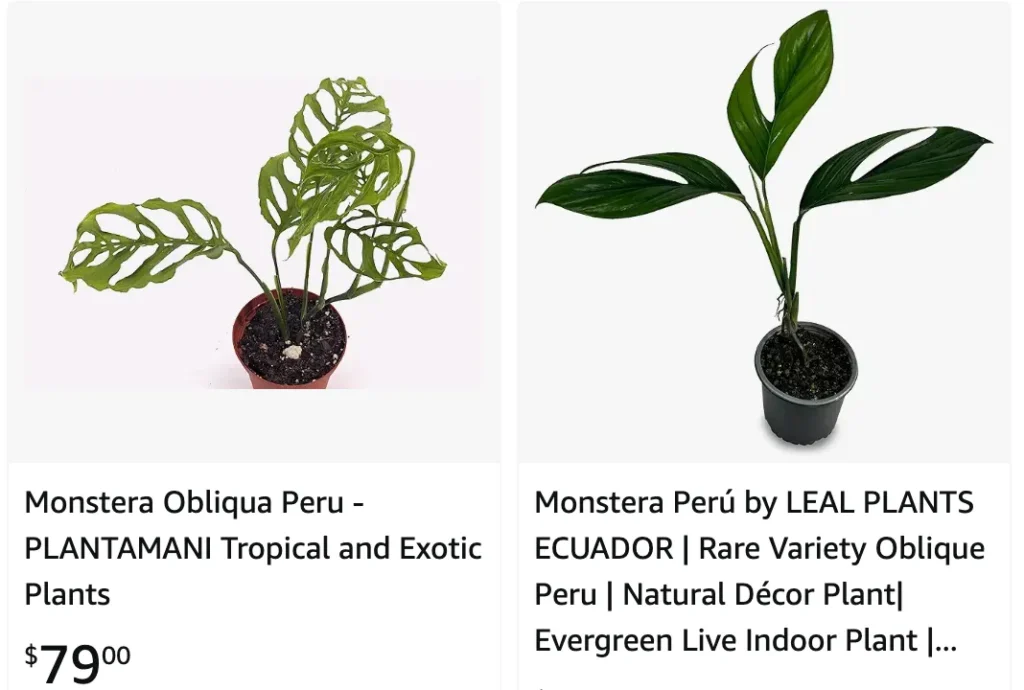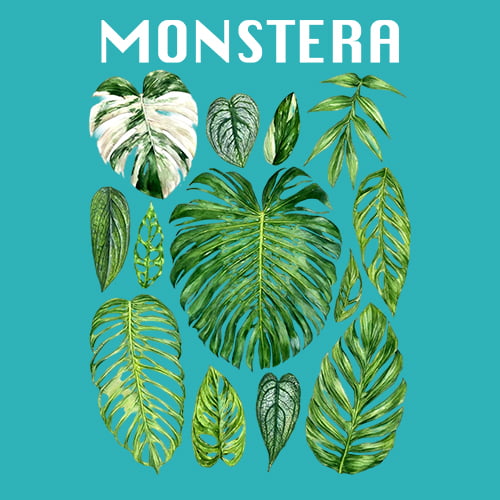
How to care for monstera obliqua?
Caring for Monstera obliqua, known for its delicate, fenestrated leaves, requires specific attention to its environmental and watering needs. Here’s how I take care of mine:
- Light: Monstera obliqua thrives in bright, indirect light. I avoid placing it in direct sunlight, which can scorch its leaves. If natural light is insufficient, a grow light can be used to supplement.
- Watering: This plant prefers consistently moist but not waterlogged soil. I water it when the top inch of soil feels dry, ensuring excess water drains out to prevent root rot. Overwatering can be a common issue, so I’m careful not to let it sit in standing water.
- Humidity: Monstera obliqua loves high humidity levels. I maintain humidity around 60-80% by using a humidifier or placing a tray of water and pebbles near the plant. Misting the leaves regularly also helps, especially during dry seasons.
- Temperature: I keep the plant in a warm environment, ideally between 65°F to 80°F (18°C to 27°C). It’s sensitive to cold drafts and sudden temperature changes, so I make sure it’s in a stable, warm spot away from open windows or vents.
- Soil: Well-draining, aerated soil is essential. I use a mix of peat moss, perlite, and orchid bark to ensure good drainage and airflow around the roots. A quality aroid mix works well too.
- Fertilizing: During the growing season (spring and summer), I feed my Monstera obliqua with a balanced, water-soluble fertilizer every four to six weeks. I reduce feeding in the fall and winter when the plant’s growth slows down.
- Pruning: To maintain its shape and health, I prune any yellow or damaged leaves using clean, sharp scissors. Regular pruning also encourages new growth and helps the plant stay compact.
- Support: Since Monstera obliqua is a climber, I provide a moss pole or trellis for it to attach to. This support mimics its natural habitat and encourages healthier, upright growth.
- Repotting: I repot my Monstera obliqua every two to three years or when it outgrows its pot. When repotting, I carefully move it to a slightly larger pot with fresh soil, being gentle with its delicate roots.
- Pests: Common pests include spider mites, mealybugs, and aphids. I regularly check the leaves and stems for signs of pests and treat any infestations with insecticidal soap or neem oil.
By following these care tips, my Monstera obliqua remains healthy, with its stunning leaves adding a touch of tropical beauty to my home.
How to propagate monstera obliqua?
Propagating Monstera obliqua can be a rewarding but delicate process. Here’s how I do it:
- Choose a Healthy Stem: Select a healthy stem with at least one node (where leaves and roots emerge) and preferably an aerial root. The node is essential for root development.
- Make the Cut: Using clean, sharp scissors or pruning shears, cut just below the node. Ensure the cutting is about 4-6 inches long and includes at least one leaf.
- Prepare the Cutting: Remove any lower leaves that might be submerged in water or buried in soil to prevent rot. Keep the top leaf or two intact.
- Water Propagation:
- Place the cutting in a jar of clean, room-temperature water, ensuring the node is submerged but the leaves are not.
- Keep the jar in a bright spot with indirect sunlight and change the water every few days to prevent stagnation.
- Roots should start to develop within a few weeks. When the roots are about 1-2 inches long, the cutting can be planted in soil.
- Soil Propagation:
- Alternatively, plant the cutting directly into a well-draining soil mix (such as a blend of peat moss, perlite, and orchid bark).
- Insert the node into the soil and water lightly, keeping the soil moist but not waterlogged.
- Cover the pot with a clear plastic bag to increase humidity, removing it daily for a few minutes to allow air circulation.
- Care for the Cutting: Place the cutting in a warm, humid environment with bright, indirect light. Avoid overwatering to prevent rot.
- Transplanting: Once a strong root system has developed, transplant the cutting into a pot with well-draining soil, water lightly, and place it in bright, indirect light.
Is monstera obliqua toxic to cats?
Yes, Monstera obliqua is toxic to cats. It contains calcium oxalate crystals, which can cause irritation, drooling, vomiting, and difficulty swallowing if ingested by cats. It’s best to keep this plant out of reach of pets.
Monstera obliqua vs adansonii
The differences between Monstera adansonii and Monstera obliqua can be subtle but important:
- Leaves: Monstera adansonii has thicker, more leathery leaves with smaller, more numerous holes. Monstera obliqua has thinner, more delicate leaves with larger perforations and often fewer overall leaves.
- Growth Rate: Monstera adansonii tends to grow faster and is more common. Monstera obliqua grows very slowly and is much rarer.
- Texture: The leaves of Monstera obliqua are almost paper-thin compared to the more robust texture of Monstera adansonii.
Monstera obliqua vs deliciosa
Comparing my Monstera obliqua to the deliciosa is like comparing a delicate lace to a bold painting. The obliqua’s leaves are so thin and fenestrated that they almost look fragile, making it a conversation piece whenever I have guests over. In contrast, the deliciosa is robust and hearty, with its thick, leathery leaves creating a strong presence in my plant collection. While the obliqua requires a bit more attention to keep it looking its best, I enjoy the challenge and the reward of seeing it thrive. Monstera deliciosa is more forgiving, making it my go-to plant for a quick boost of greenery.
Monstera obliqua vs esqueleto
The obliqua, with its highly perforated leaves, almost looks like it’s barely there, which gives it an ethereal quality. On the other hand, the Monstera esqueleto’s leaves have larger holes and a more structured appearance, making it a bit sturdier and less delicate in comparison. I find the esqueleto easier to care for, as it seems more resilient, while the obliqua demands a bit more precision with its humidity and light requirements.
Monstera obliqua vs Obliqua Peru
The standard obliqua is famously rare and almost ghostly with its extreme fenestration, giving it a very exotic look. Meanwhile, the Obliqua Peru is a bit more robust, with thicker leaves that have fewer, but still impressive, holes. I find the Obliqua Peru to be slightly more adaptable to my home’s conditions, making it a bit easier to care for than the ultra-delicate obliqua.
Why is monstera obliqua so expensive?
Monstera obliqua is expensive due to its rarity, slow growth rate, and the difficulty of propagation. The plant’s delicate nature and the high demand among collectors also contribute to its high price.
Why is monstera obliqua so rare?
Monstera obliqua is rare because it grows very slowly and is difficult to propagate. Its specific habitat requirements in the wild and the delicate nature of its leaves make it less commonly found and cultivated compared to other Monstera species.
What kind of fertilizer to give to monstera obliqua?
For Monstera obliqua, I use a balanced, water-soluble fertilizer with an N-P-K ratio of 20-20-20 or similar. During the growing season (spring and summer), I fertilize once a month, diluting the fertilizer to half the recommended strength to avoid overfeeding. In the fall and winter, I reduce or stop fertilizing as the plant’s growth slows down.
Where to buy monstera obliqua?
Monstera obliqua can be found through specialized online plant retailers, plant nurseries, or from collectors who might sell cuttings. Websites like Etsy, specialized plant shops, and sometimes local plant swaps or botanical garden sales are good places to check. Due to its rarity, availability can be limited, and prices can be high.




